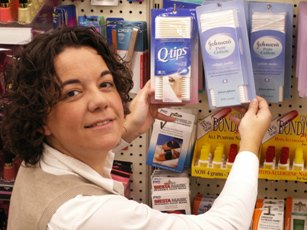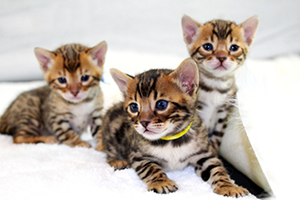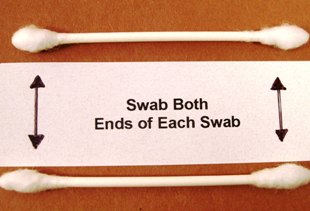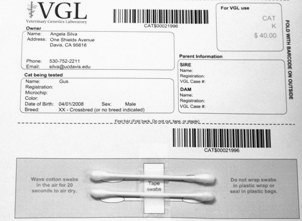Quick Summary
Click here for Price and Turnaround Time
A DNA profile of species-specific microsatellite markers is obtained from the offspring, potential dam, and potential sire(s), and parentage analysis is performed using this data. In this process, a computer program compares the DNA profile of the offspring to the profiles of the presumed parents. Candidate sires and dams may either qualify or be excluded as parents based on whether they share microsatellite marker alleles with the offspring. A parentage analyst then reviews the results and sends the final report. If a listed parent or parents are excluded, additional analysis is performed, including retesting of samples and the possible use of additional DNA markers to confirm the exclusion.
You can read more about the process of DNA parentage analysis HERE.
Cat DNA tests are carried out using cells brushed from your cat's cheeks and gums using household cotton swabs.
The cat DNA submission form with instructions and a place to tape the cotton swabs is sent to you via email after you place an order, and can be printed from your home computer. DNA test kits are no longer mailed.
Instructions
Step-By-Step:
1.
 Purchase regular household cotton swabs for cat DNA collection (the cotton swabs can be purchased at a pharmacy or drug store)
Purchase regular household cotton swabs for cat DNA collection (the cotton swabs can be purchased at a pharmacy or drug store)
2.

Make sure the cat has not had anything to eat or drink for at least 1 hour prior to collecting sample.
When swabbing kittens, isolate each kitten from the mother, littermates and any shared toys for 1 hour prior to swabbing. Kittens should not have nursed or eaten for 1 hour prior to collecting sample.
If collecting samples from more than one cat, make sure to sample one cat at a time and wash your hands before swabbing another cat.
3.
 Use both ends of the two cotton swabs for a total of four swabs.
Use both ends of the two cotton swabs for a total of four swabs.
4.
Place the cotton head of the swab between the cat’s gums and cheek and rub or rotate the swab back and forth for 15 seconds. Repeat with each cotton swab head, for a total of 4 swabs. We recommend swabbing a different area of the gums with each swab head.
5.
Wave the swab in the air for 10-15 seconds to air dry it before attaching it to the submission form.
6.
 After swabbing the cheek and gums, tape the cotton swabs to the bar-coded submission form printed from your MyVGL account.
After swabbing the cheek and gums, tape the cotton swabs to the bar-coded submission form printed from your MyVGL account.
ATTENTION:
- Do not collect saliva/drool – the key to obtaining a good sample is getting cheek cells on the swab.
- Do not rub swab on the cat’s tongue or teeth – this will result in poor quality sample.
- Do not collect a sample from a kitten that has recently nursed – the mother’s genetic material can rub off on the kitten’s mouth and contaminate the sample.
In cats, the following microsatellite markers are reported:
FCA005
FCA224
FCA229
FCA293
FCA310
FCA441
FCA453
FCA649
FCA678
FCA026
FCA069
FCA075
FCA097
FCA105
FCA149
FCA201
FCA220

 Parentage/Genetic Marker Report
Parentage/Genetic Marker Report